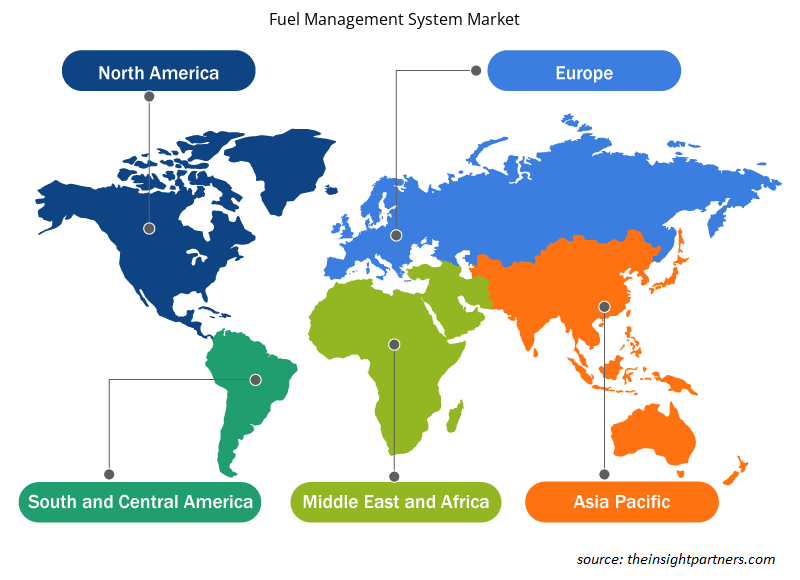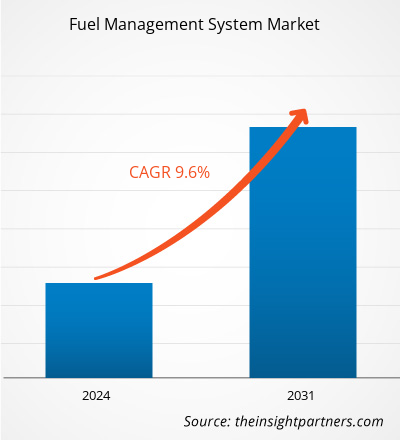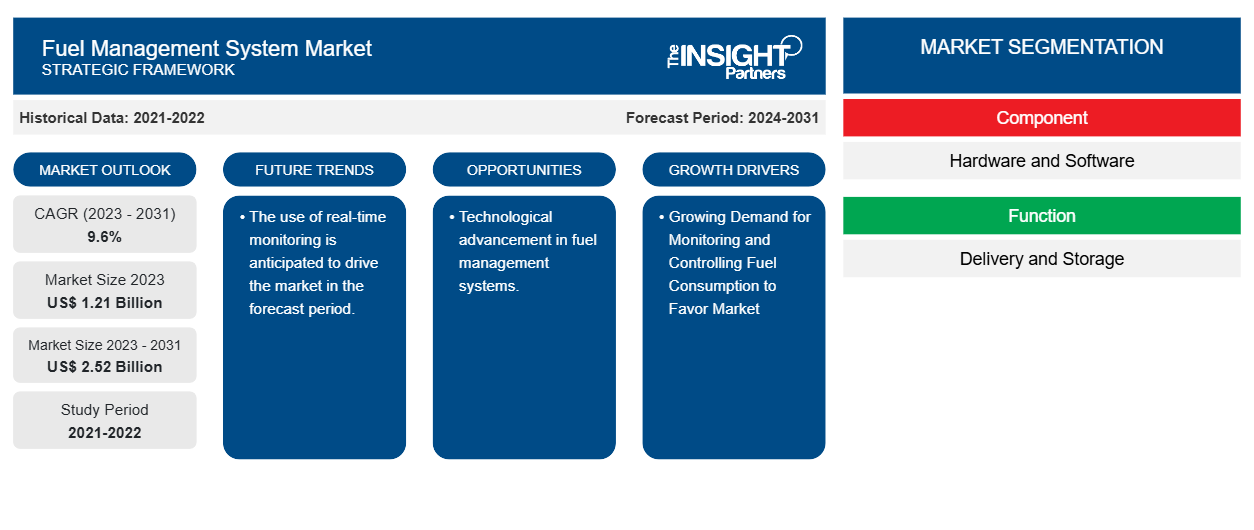预计燃料管理系统市场规模将从 2023 年的 12.1 亿美元增至 2031 年的 25.2 亿美元。预计 2023-2031 年期间市场复合年增长率将达到 9.8%。对燃料消耗监控和控制的需求不断增加以及燃料盗窃案件的增加可能仍是市场的主要趋势。
燃料管理系统市场分析
随着各行各业对更好的燃料管理的需求不断增长,以提高生产力和效率,燃料管理系统市场的需求预计将增长。此外,电子商务平台的快速发展为提供更好的客户体验,推动了供应和物流行业加强物联网行业。
燃料管理系统市场概览
燃料管理系统是一种软件和硬件技术,用于监控、控制和优化各种应用(例如运输、建筑和能源行业)中的燃料消耗。在车辆中,燃料管理系统可以通过监控燃料消耗、发动机性能和其他因素来帮助确保燃料得到有效利用。这有助于降低燃料成本、提高运营效率并减少排放。
定制此报告以满足您的需求
您可以免费定制任何报告,包括本报告的部分内容、国家级分析、Excel 数据包,以及为初创企业和大学提供优惠和折扣
-
获取此报告的关键市场趋势。这个免费样品将包括数据分析,从市场趋势到估计和预测。
燃料管理系统市场驱动因素和机遇
油耗监测与控制需求增长利好市场
对燃料消耗监测和控制的需求不断增长,推动了燃料管理系统市场的发展,因为监测燃料消耗具有多种好处。例如节省成本、识别低效率、减少排放等。此外,对实时燃料消耗监测的需求也在增加。它使企业能够在燃料浪费发生时而不是事后识别和处理。这可以帮助企业实时降低燃料消耗和成本,从而对其利润产生重大影响。考虑到监测和控制燃料消耗的多种好处,燃料管理系统的需求量很大。
燃料管理系统的技术进步。
燃料管理系统的技术进步带来了许多机遇。物联网集成、预测分析、机器学习算法、透明区块链、节能汽车等技术进步可以帮助多个行业,包括物流和运输、制造和供应链、农业、建筑、车队管理和服务等。因此,各个行业的技术进步增加了对燃料管理系统的需求。
燃料管理系统市场报告细分分析
有助于得出燃料管理系统市场分析的关键部分是组件、功能和最终用户。
- 根据组件,燃料管理系统市场分为硬件和软件。预计软件部分将在预测期内占据相当大的市场份额。
- 根据功能,燃料管理系统市场分为运输和储存。预计运输部分将在预测期内占据相当大的市场份额。
- 根据最终用户,市场分为采矿、建筑和港口、运输和物流、石油和天然气等。预计采矿业将在预测期内占据相当大的市场份额。
燃料管理系统市场份额(按地区)分析
燃料管理系统市场报告的地理范围主要分为五个区域:北美、亚太、欧洲、中东和非洲、南美和中美。
北美一直主导着燃料管理系统市场。北美地区各行业的高科技采用趋势推动了燃料管理系统市场的增长。数字工具的采用率提高和政府机构的高技术支出等因素预计将推动北美燃料管理系统市场的增长。此外,美国和加拿大等发达经济体高度重视研发,这迫使北美参与者将技术先进的解决方案引入市场。此外,美国有许多燃料管理系统市场参与者,他们越来越专注于开发创新解决方案。所有这些因素都促进了该地区燃料管理系统市场的增长。
燃料管理系统市场区域洞察
Insight Partners 的分析师已详尽解释了预测期内影响燃料管理系统市场的区域趋势和因素。本节还讨论了北美、欧洲、亚太地区、中东和非洲以及南美和中美洲的燃料管理系统市场细分和地理位置。

- 获取燃料管理系统市场的区域特定数据
燃料管理系统市场报告范围
| 报告属性 | 细节 |
|---|---|
| 2023 年的市场规模 | 12.1亿美元 |
| 2031 年市场规模 | 25.2亿美元 |
| 全球复合年增长率(2023 - 2031) | 9.6% |
| 史料 | 2021-2022 |
| 预测期 | 2024-2031 |
| 涵盖的领域 |
按组件
|
| 覆盖地区和国家 |
北美America
|
| 市场领导者和主要公司简介 |
|
燃料管理系统市场参与者密度:了解其对业务动态的影响
燃料管理系统市场正在快速增长,这得益于终端用户需求的不断增长,而这些需求又源于消费者偏好的不断变化、技术进步以及对产品优势的认识不断提高等因素。随着需求的增加,企业正在扩大其产品范围,进行创新以满足消费者的需求,并利用新兴趋势,从而进一步推动市场增长。
市场参与者密度是指在特定市场或行业内运营的企业或公司的分布情况。它表明在给定市场空间中,相对于其规模或总市场价值,有多少竞争对手(市场参与者)存在。
在燃料管理系统市场运营的主要公司有:
- Chevin 车队解决方案
- 富兰克林电气
- 吉尔巴科公司
- Multiforce 系统公司。
- 导航8
- 皮乌西公司
免责声明:上面列出的公司没有按照任何特定顺序排列。

- 了解燃料管理系统市场顶级关键参与者概况
燃料管理系统市场新闻和最新发展
燃料管理系统市场通过收集一手和二手研究后的定性和定量数据进行评估,其中包括重要的公司出版物、协会数据和数据库。燃料管理系统市场的一些发展情况如下:
- Kongsberg Digital 和 Royston 合作提供电子燃料管理系统。此次合作将使船东能够优化燃料消耗、提高透明度并促进船舶运营脱碳,方法是将 Kongsberg Digital 的 Vessel Insight 与 Royston 的电子燃料管理系统 Enginei 相结合。(来源:Royston,Press Company 网站,2024 年 2 月)
- 空客与可持续航空燃料 (SAF) 领域的新兴领导者 DG Fuels, LLC(“DGF”)成为战略合作伙伴。DGF 的燃料生产系统完全基于纤维素废料,例如伐木业产生的木材废料,以及风能和太阳能等可再生能源。(来源:空客公司网站,2023 年 9 月)
燃料管理系统市场报告范围和交付成果
“燃料管理系统市场规模和预测(2021-2031)”报告对市场进行了详细分析,涵盖以下领域:
- 范围内涵盖的所有主要细分市场的燃料管理系统市场规模及全球、区域和国家层面的预测。
- 燃料管理系统市场趋势以及驱动因素、限制因素和关键机遇等市场动态。
- 详细的 PEST/波特五力分析和 SWOT 分析
- 燃料管理系统市场分析涵盖主要市场趋势、全球和区域框架、主要参与者、法规和最新的市场发展。
- 行业格局和竞争分析涵盖市场集中度、热图分析、知名参与者以及燃料管理系统市场的最新发展。
- 详细的公司简介。
- 历史分析(2 年)、基准年、预测(7 年)及复合年增长率
- PEST和SWOT分析
- 市场规模、价值/数量 - 全球、区域、国家
- 行业和竞争格局
- Excel 数据集
近期报告
相关报告
客户评价
购买理由
- 明智的决策
- 了解市场动态
- 竞争分析
- 客户洞察
- 市场预测
- 风险规避
- 战略规划
- 投资论证
- 识别新兴市场
- 优化营销策略
- 提升运营效率
- 顺应监管趋势























 获取免费样品 - 燃料管理系统市场
获取免费样品 - 燃料管理系统市场